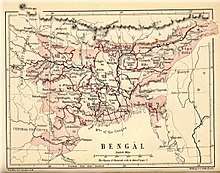Chandra dynasty
The Chandra dynasty was a Kayastha dynasty, originating from the Indian subcontinent, which ruled the Samatata region of Bengal, as well as northern Arakan. The reign of the dynasty was between the 10th and 11th centuries or as early as or before 3rd century AD. It was a neighbor to the more powerful Pala Empire to the north.
History
Ananda Chandra inscription (729 AD) mentions king Chandrodaya whom Sircar fixes the date of 202-229 AD. The inscription mentions kings prior to King Chandrodaya as "zealous in doing kindness to the world". The ye Dhamma inscriptions of Queen Niti Chandra are dated to early 6th century AD based on paleographic grounds.[1]
The Chandra kingdom was one of the last Buddhist strongholds in the Indian subcontinent. The kingdom flourished as a center of the Tantric schools of Buddhism. It played a role in the diffusion of Mahayana Buddhism to Southeast Asia.[2]
The dynasty was founded by Traillokyachandra, who was a descendant of Kayastha landlords in the Lalmai region between Comilla and Tripura. The second ruler Srichandra led invasions into Kamarupa. The Chandras played an important role in the regional politics and military history of erstwhile Bengal. The Chandras supported the Pala Empire in the west against North Indian and South Indian invasions.[3]
The Chandras were eventually overthrown during an invasion of the South Indian Chola dynasty.[3]
Maritime relations
The coastal kingdom had trade networks with states in what is now Myanmar, Thailand, Indonesia and Vietnam. 10th century shipwrecks around the coast of Java provide evidence of maritime links between southeastern Bengal and Southeast Asia. Bronze sculptures may have been imported by the Javanese from the Chandra kingdom in southeastern Bengal. Arab merchants also traded with the kingdom.[2]
Archaeology
There are numerous inscriptions dating from the period of the Chandra dynasty. The three archaeological sites associated with the dynasty include Bikrampur and Mainamati in Bangladesh and Waithali in Rakhine State, Myanmar (Burma).
List of kings
The five Chandra king are listed in the following.
- Traillokyachandra (900–930 CE)
- Srichandra (930–975 CE)
- Kalyanachandra (975–1000 CE)
- Ladahachandra (1000–1020 CE)
- Govindachandra (1020–1050 CE)
References
- Manguin, Pierre-Yves; Mani, A.; Wade, Geoff (2011). Early Interactions Between South and Southeast Asia: Reflections on Cross-cultural Exchange. Institute of Southeast Asian Studies. ISBN 978-981-4345-10-1.
- Ghosh, Suchandra (2013). "Locating South Eastern Bengal in the Buddhist Network of Bay of Bengal (C. 7th Century CE-13th Century CE)". Proceedings of the Indian History Congress. 74: 148–153. JSTOR 44158810.
- http://en.banglapedia.org/index.php?title=Chandra_Dynasty,_The
Bibliography
- Singh, Nagendra Kr. (2003). Encyclopaedia of Bangladesh. Anmol Publications Pvt Ltd. pp. 7–21. ISBN 81-261-1390-1.
- Majumdar, Ramesh Chandra (1943). The History of Bengal. Dacca: B.R. Publishing. pp. 134–135, 192–197. ISBN 81-7646-237-3.
- Chowdhury, Abdul Momin (1967). Dynastic History of Bengal. Dacca: The Asiatic Society of Pakistan.
- Chowdhury, A. M. (2012). "Chandra Dynasty, The". In Islam, Sirajul; Jamal, Ahmed A. (eds.). Banglapedia: National Encyclopedia of Bangladesh (Second ed.). Asiatic Society of Bangladesh.
